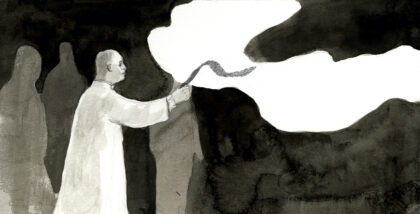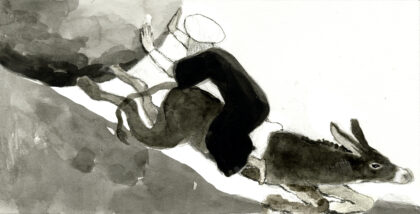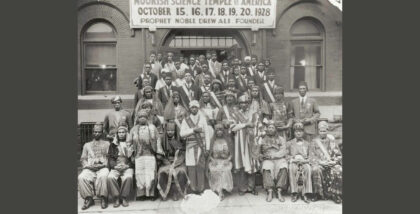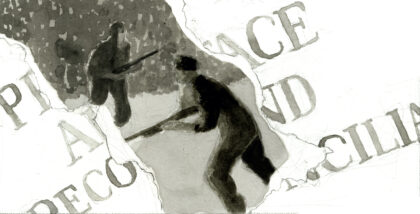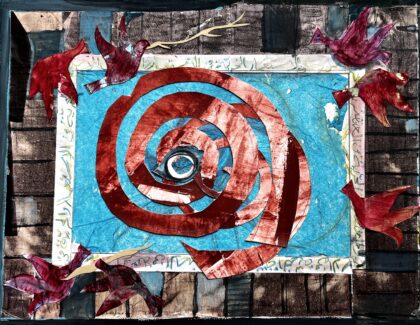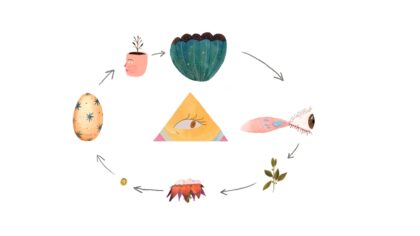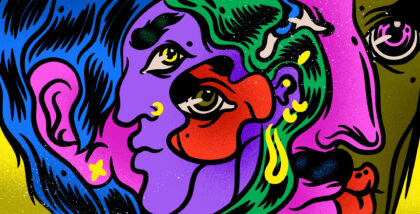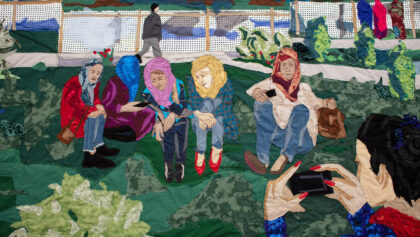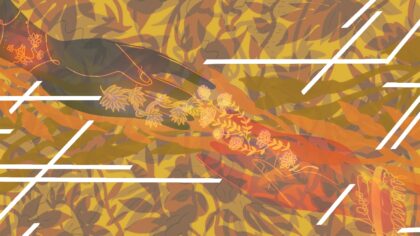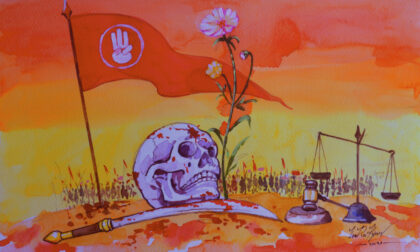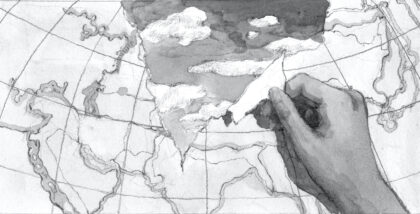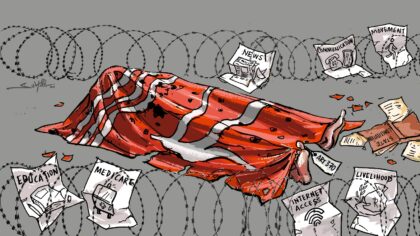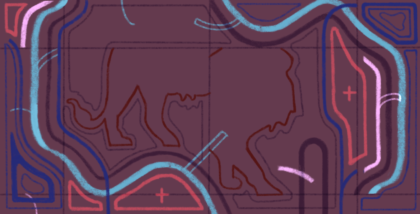 Cape Town, South Africa. Photo courtesy of Kanisha Bond.
Cape Town, South Africa. Photo courtesy of Kanisha Bond.
It was whiteness that pushed many of us outside the hallowed halls of academia. Displaced within or outside institutions, a deep commitment to our own political projects determined the strategic position we would each eventually occupy: infiltrating, dismantling, and disrupting the entrenched hierarchies of our disciplines. This was a struggle that often began alone, until we found each other.
One such collective of comrades convened, a few years ago now, in a session at Columbia University in New York aptly titled Women Waging War. It was here that I first had the chance to absorb the thinking of political scientist and activist Kanisha Bond, who articulated the struggles of her subjects, intertwined with her own experiences in academia and policy, with stark insight. A “student of insurgency” whose work examines the underpinnings of violence, social movements, and ideologies, Dr. Bond has, throughout her career, pushed both public policy debates and private movement-building conversations to unearth and confront layers of structural inequality alongside the traumas they produce and reproduce.
Situated now as an assistant professor of political science at Binghamton University, Dr. Bond has studied the mechanics of contentious mobilization in Africa and the United States with a keen eye toward the role of culture and identity inside these spaces. As January’s Capitol riots unfolded and settled in my own mind, I wondered how the moment pulled at both the pain and curiosity of women like Kanisha: women forced to constantly relive a feeling of exile from their own existence inside American society and the institutions that sustain the whiteness at its core. Our wide-ranging conversation probed the language of terror, Antifa as a foil for white nationalism, and policymaking “performed through kinetic engagement.”
*
Nimmi Gowrinathan: This issue is about how whiteness operates in the policy world in unexpected or uninterrogated ways. Not simply the demographic hegemony of white people running the policy world, but how whiteness actually maneuvers in the crafting and execution of policies. How do you think we should be looking at this question?
Kanisha Bond: Whiteness itself, as an orienting worldview, gets lost in the policy world. People get stuck in the historicity of the current moment, blind to the whiteness that has produced the institutions we’re working within.
Nimmi Gowrinathan: Your work in particular pushes us to collapse the boundaries of how we grapple with whiteness in this country and how it manifests in other spaces and other countries. The policy world tends to work in the constructed categories of either domestic or foreign policy, but whiteness is the insidious force that breaks down that barrier. How do you see the continuity of whiteness between policies designed for “home” and “abroad”?
Kanisha Bond: Whiteness—and American whiteness in particular—can present as very different things. For people who recognize whiteness in the policy space at all, the immediate link is the War on Terror—not only the language around it but actual execution of law enforcement, the penalizing behaviors that are transgressive of the standing political order. What is terror? What is terrorism? Globally, it’s deeply informed by the American perspective.
In the aftermath of, I’m not sure what to call [January 6th], a riot, an insurrection, or really the first stages of the boogaloo (which is what many who were there thought it was)—there is this “new” recognition, or the recent epiphany that there is a such thing as domestic terrorism that can be carried out by Whites. I of course think back to Oklahoma 1995, but perhaps now we’ll see some changes in how the concept of whiteness informs the concept of terror and vice versa.
In dealing with terror, domestic policy and foreign policy get elided because the agencies that are tasked with responding to both follow the same formula. Once you acknowledge that, it may not be fair or useful for us to expect that they would have different orienting worldviews to dealing with one space versus the other. It’s just shades of the same.
Nimmi Gowrinathan: In terms of the term “terrorism,” it often feels like public figures are grasping for available language to denote the shock or the extremity of a particular moment. Progressive folks somewhat easily adopt a framing—terrorism—that has been the tool of oppression for many people of color. The practice feels like reinforcing a problematic label. How does one navigate the desire to emphasize the danger of white supremacy without falling back on the language of terror?
Kanisha Bond: The difference between terrorism as a latent thing and terrorism as an observable action is probably really important here. What happened on the Hill was terrifying: the active attempts at lynching and the violent seizing of collective goods, the building of talismans to a violence that is not just ideologically-oriented but also appears with a kind of blood lust. That political reality has been terrifying for a lot of brown, Black, and not-white people in this country for a really long time. So the repurposing of the language is convenient from my perspective.
The centrality of whiteness to understanding what “terrorism” is in the US reserves the term for things that victimize—actually or perceptually—white America.
The language has always been there, but the power behind the language has not been acknowledged because it was the victims [Black and brown people] who used the language. So now that the perpetrators have decided to adopt that language for themselves, it’s some sort of signal that they understand the gravity of what’s happening. That terrorism is the word the traditional perpetrators of terror use to describe the intensity of the situation just reveals how superficial their analysis is.
Nimmi Gowrinathan: The Capitol riots were of course shocking in their immediacy and their visual presence. But having a different view on the longevity of this process of white nationalism, was it for you simply the logical end to the Trump era, or part of a longer trajectory that extended before and continues ahead of that one moment?
Kanisha Bond: Yeah, it was certainly an escalation. I can’t say that I ever imagined this though, or foresaw the details: a large popular insurrection that’s armed, that aims itself at those who the rioters understood to be elites, and particularly traitorous elites. It’s what they were betraying that is interesting: the moment is multi-layered.
But this is what many folks in the United States and in Canada and other places in the world have been preparing themselves for. I was in Charlottesville and I saw a kind of prepared white nationalism run amok. And I’ve been at state capitols across the East Coast and seen armed white nationalism find an opportunity to display itself. I don’t put it past people who share that ideology to be organized and to work collectively and to do the sorts of things that could make a siege like that successful.
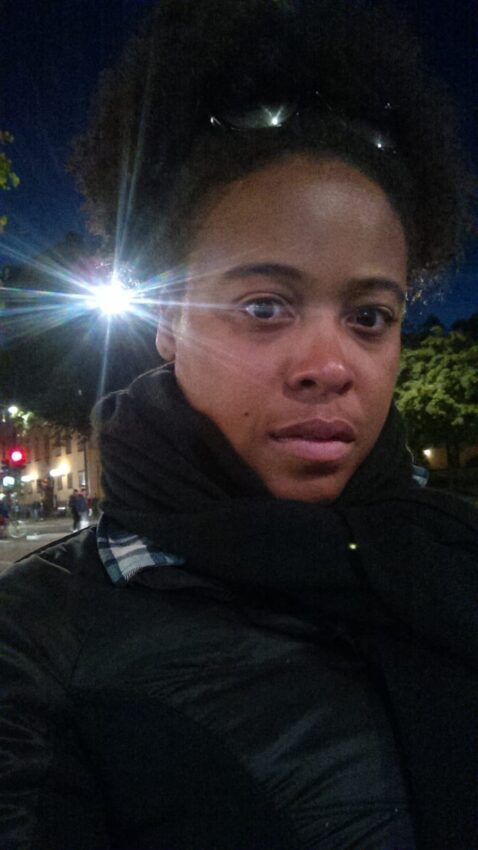
Nimmi Gowrinathan: I want to hear your thoughts on the role of violence in understanding the dangers of an ideology. How does the use of violence protect or open white nationalists up to a different kind of scrutiny? And how much does the mode of expression matter?
Kanisha Bond: One really interesting thing about all of this is that violence as an act in itself is incredibly relative. So whether one would characterize, for example, busting out of a window as violent or not depends on the frame through which you’re coming to observe the act as well as the actor engaging in violence.
I remember when I was doing crowd observations during the protest and the mobilization spurred by Trump’s inauguration on K Street in DC. And one of the iconic images from that day was this limousine that had had its windows broken out and was set on fire.
I was walking down the street when law enforcement were starting to cordon off the limo. The limo wasn’t actually on fire until it was already guarded, which is an interesting point in the chronology. But I had asked someone, “What happened here?” And they said, “Oh, the protesters are getting out of control, they’re breaking windows and we have to guard this because this is a crime scene.”
The street was sparsely populated at that point. Maybe it was just a relic of the chaos of the day. But I remember writing in my field notes: they’re breaking windows now. This was evidence of the escalation, and now the violence had started.
Juxtapose that with the images on CNN and every other channel of people breaking the bulletproof glass in the Capitol in order to jump through the window. It took a long time for me to hear that specific act discussed as violence. This was just a thing that happened.
My concern, and maybe also my expectation, is that when the things that actually are physically damaging—intended or likely to produce distress, harm, injury, or death—when they are done by folks with a white supremacist ideology, it will just be a thing that happened, in the course of some ideologically-motivated vision quest.
Nimmi Gowrinathan: Yes, in the aftermath of the riots we saw quite a bit of juxtaposed imagery of the security forces present for Black Lives Matter and other protest movements versus the Capitol. What role does highlighting this contrast play in shifting either policy or public consciousness? Does it simply lay bare the obvious reality of lives lived in a deeply divided society, or can this approach inspire mobilization?
Kanisha Bond: I don’t actually think it matters. Maybe it’s understandable, though, because the race for equality for many people is like a leveling. If it matters for you, it should matter for me, and vice versa, and so therefore we know it’s fair. But equality and justice are not the same thing. This tactic of: Black Lives Matter or anyone else gets treated in X way and a crazed largely white mob of insurrectionists acts in Y way, so we need to figure out how to make those equivalent—that’s not the point. I don’t think it should be the point, right?
What is the value of breaking a window when you are not a man, not white, do not have American citizenship, are not landed, not wealthy?
I think the point should be: here’s this tool, the act of physical protest, that multiple groups of individuals have found to be politically useful. What is the underlying political analysis? What is the power in breaking a window when you are white and dressed in a costume? What is the power of breaking a window when you are unidentifiable either because of the outfit that you’ve put on or because no one’s looking at you? What is the value of breaking a window when you are not a man, not white, do not have American citizenship, are not landed, not wealthy, not supposed to be able to do something like break a window or construct a gallows on the Capitol grounds, certainly without consequence?
Nimmi Gowrinathan: That’s an important point. This moment really unveiled the brazen visibility, even the absurd visibility, of this ideology. In the analysis of the motivations of this group, the other element that emerges is Antifa as the foil for white nationalists. Antifa is often cited but rarely understood in its historical context. Could you share your thoughts on where the movement is today and how it got there? And perhaps, also, the position it often occupies as the protagonist in the white nationalist narrative of justified violence?
Kanisha Bond: We don’t know much about Antifa partially by design. It’s hard to ask any kind of criminalized activist movement to be as transparent and as open as you’d often like to better understand the forces that they organize against.
I don’t tend to think about militant anti-fascism or what we commonly call Antifa as a movement per se. I think about it as something more like an industry. There’s a kind of a single orienting worldview, in resistance to fascism and with an interest in dismantling fascism, wherever you should find it. From its earliest days in the US, people who might call or organize themselves as Antifa were as interested in routing white nationalism and neofascism out of social spaces—like punk culture, or the ska/reggae music scene—as much as out of more “traditional” political spaces, like local, state, or federal political office. So it’s not something that’s only institutionalized politics. It’s not something that would only be relevant at a ska show. It’s all of it.
But the way that it’s executed in different places and in different times can vary so significantly that when you really drill down, it can be hard to actually put the different moments and different sub-institutions that manage mobilization into a single bucket. Just like any movement, there will be different elements that agree and disagree. There are a variety of tactics and strategies that will be acceptable to some and not acceptable to others. It’s about combating fascism, and the degree to which anti-Blackness is understood as a part of any political ideology will vary significantly across individuals and collectives. There’s a general animating idea that if you’re down with it, you’re Antifa, but the specific way that you do it is going to be really local. It’s going to be specialized to the people that are interacting with each other at any point in time.
Organizationally, the same is true with respect to Black Lives Matter. It’s a little bit more like a franchise that you can take up as long as you agree with the underlying common denominator. But to distinguish here, Antifa is not necessarily organizing around combating anti-Blackness, whereas that fight is at the core of what animates the Movement for Black Lives, including Black Lives Matter as a specific entity.
I don’t know if the people who subscribe to military anti-fascism as an ideology think that they’re redeeming whiteness, but in practice that can be what it looks like.
That said, I think there’s this real foiling [between Antifa and white nationalists]. I really love that language and I’m trying to figure out how to do justice to it. Because I think there’s this expectation that there are Good Whites and Bad Whites. And the good whites are willing to get in the face of the bad whites and stare them down and in doing that either inadvertently provide cover for everybody that the bad whites are targeting or out them in search of redemption. Sounds like what some hoped would happen among Black and brown communities in the civil and labor rights eras, or among Muslim communities in the post-9/11 era.
I don’t know if the people who subscribe to military anti-fascism as an ideology think that they’re redeeming whiteness, but in practice that can be what it looks like at times.
Nimmi Gowrinathan: Can you tell us a bit more about the specific research and thinking you are doing around Antifa?
Kanisha Bond: From my perspective, we get a lot of caricatures of Antifa, of militancy and of anti-fascism without critical analysis of those things as being separate though linked, and certainly without any real critical analysis of the racialized layers within.
I’m trying to understand how experiences and contributions of non-white people have produced what we currently see as a military anti-fascist complex in North America. What sorts of things have people who are not white done? How does the unique American perspective on race, class, and authoritarianism influence this particular brand of resistance to fascism? How much is that based in combating anti-Blackness? How much of it reproduces anti-Blackness? How much of that works its way into fundamental political analysis?
Nimmi Gowrinathan: Policymakers don’t often examine the ideas and images that inform their own biases. How an individual moment of caricature might find its way into a policy that will then be amplified across the country, and the world. What forces push false constructions along? Social media? General media? Academic writing? Specifically, what are the spaces the policy world absorbs anti-Blackness from?
Kanisha Bond: I’ve been thinking a lot actually about state misinformation and disinformation campaigns that are intended to disrupt American politics in some way. So for example, if you think about the Russian bots specifically and systematically producing web content that was supposed to be read as coming from a Black voice. Someone recognized—realized?—that the claims and grievances and experiences of many Black Americans against America are politically potent, and that to express them with a militant posture would be destabilizing here.
The super hype trope of “Black equals mad” is the voice that they chose, though. That suggests that there are people—who are both consumers/observers of American culture and ensconced in the everyday policy-making process in the United States from abroad, and who have absorbed and reproduced and studied American anti-Blackness through performing this very specific caricature—who are quite able to weaponize American fears of foreign capability and domestic otherness as two sides of the same coin.
The point is that when it becomes hard to tell the difference between a disgruntled “Black” Russian bot from the boogeyman of Russia and the boogeyman of a disgruntled Black person, the boogeyman of a chocolate city somewhere, that’s where you start to realize that it’s a real folly to expect that policy development comes from any place other than where a Black Lives Matter protest comes from, or where the Capitol insurrection comes from.
I mean, no one here is divorced from the context in which we live. And there’s an unfortunate tendency for folks involved in “high politics” to assume that they are. But the low down dirty everyday work of dismantling all systems of oppression, particularly anti-Blackness in the American policy-making space, is going to be fundamentally individual.
Nimmi Gowrinathan: That word “disgruntled” strikes me as not your word of course, but as a perception. It maps onto other dismissive terms from the FBI and others for the legitimate grievances of Black and brown folks, such as “wound collectors.” In thinking about white nationalists, and other such groups, it feels critical to parse the perceived versus the real threats to life. I don’t think we can simply accept that one group believes they’re under threat and can occupy legitimacy in that way, no?
Kanisha Bond: Yeah. Or the time horizons are a little bit different and that’s okay. Chronic institutional threats that are very acute in execution are different from existential nervousness. But I think there are quite a lot of white folks in America who are living that joke that, “Well, now white people are figuring out what it’s like to be Black. They’re learning what it’s like to be Black. They feel it. Like, oh, you actually can see them.”
I’m sure that there were quite a few white folks in the Capitol who, in their minds, were thinking about their life circumstances as making them almost like Black people. Or who are experiencing now, to their minds, some restrictions of movement and freedom that make them “no better than a Muslim.” And that infuriates them. It challenges everything that they want to believe justifies their disdain and neglect and blame of others.
Nimmi Gowrinathan: If you were going to create a Venn diagram of anti-Blackness and the policy world, both domestic and foreign, where does white feminism sit? Is it completely overlaid with anti-Blackness? We know, of course, that white feminism drives anything “gendered” in policy, but in relation to Blackness is it reinforcing structures of violence or acting as a corrective?
Kanisha Bond: Trying to visualize it right now, I might call the white feminist ideal coterminous with the foreign policy circle. Because I think the expectations of what American foreign policy can do—pie in the sky liberal expectations of what American foreign policy will and should do—are in line with the expectations of what makes womanhood good and special and right in the white feminist conceptualization.
I say coterminous with the foreign policy circle because I don’t think it shows up in the domestic policy consciousness in that way. This is both my gut and also my take on responses to violence domestically—the degree to which masculinized policy as well as policy rooted in misogyny domestically tends to clash with what the United States needs to demonstrate in the foreign theater.
Nimmi Gowrinathan: Can you say more about masculinized policy? What do you mean by that?
Kanisha Bond: I mean the idea of power as something that’s only physical. It’s only performed through kinetic engagement. That it’s hard and it’s tough and it’s strategic, but it’s not crafty. And it’s breakable but not weak, though success is going to require everything we got. Even as it is not meant to produce anything else, but just reproduce itself. That’s really different.
I think the liberal idea of diplomacy is built on the value of nuance, whereas domestically there is no diplomatic nuance in the United States. Unless you’re a white landed man with a bunch of sons and the audacity to arm yourselves and stand at the edge of your property and tell the federal government that they have no standing there.
For example, I’ve been the most intrigued and scared by what Cliven Bundy and his family and his friends were able to pull off. Similarly, Ruby Ridge and Waco. That’s a different class of things in the American response to domestic violence than the Oklahoma City or Atlanta bombings, or even attacks against abortion providers.
Nimmi Gowrinathan: Yeah. There seems to be a quotidian nuance available to “extremist” white folks—detailed life histories that build up to this collective grievance, a divorce or a difficult childhood laid out in intimate form, linked to whatever burgeoning political identity they assume—stories that rarely include an actual moment of violence from the state.
Kanisha Bond: I’ve been conducting interviews with folks that would self-identify as subscribing to some degree of military anti-fascist thought. The white interlocutors that I’ve interacted with have tended to recall their mobilization as being based in things that were happening to other people that they cared about, that they saw as wrong.
So not necessarily some sort of white saviorism, but this idea that they were uniquely positioned to be able to get out in front of somebody who was systematically vulnerable. And it was their job to do that because they wanted a better world.
The non-white folks that I’ve spoken to have all used some language of empowerment. Somebody needed to do it and they were sick and tired of being sick and tired. And so they decided to take matters into their own hands. Take their liberation into their own hands, not wait for somebody else to recognize their vulnerability.
There’s a metanarrative about white saviorism that maybe you wouldn’t expect there. I think I can say that after having had extended interactions with these people. It’s not malicious, but it’s insidious—how invisible it can be.
Nimmi Gowrinathan: I won’t ask you to end with a superficial nod to optimism—recognizing that political action can come from a very dark place sometimes, and the only way to move through it is to stay in that dark place rather than simply looking for something that provides somebody else with a sense of positivity—but perhaps a realistic picture of where we are.
Kanisha Bond: We started by talking about whiteness in terms of what it does. It’s the freedom to say, “I recognize myself in some superior position in some non-existent hierarchy, and I have the audacity to be upset when I’m losing it.”
Whiteness might not be malicious, but it is insidious. It’s not intended to hurt you, but it absolutely will.
People who expected all of a sudden that with a new American president, American leadership is going to be restored. And all of a sudden, America is an example to look to in global politics again. What was that hierarchy that produced American exceptionalism or value in the first place? It was imperialism. It was violent, exclusionary, degenerate imperialism.
Like, the Capitol building is, yes, symbolically important and maybe operationally important, but is it any more important than any given home of a sharecropper who got ran up in the middle of the night by a bunch of white guys with hoods and torches?
We’ve been in this moment for a very long time. And the hard thing to square is [that whiteness] might not be malicious, but it is insidious. It’s not intended to hurt you, but it absolutely will.
